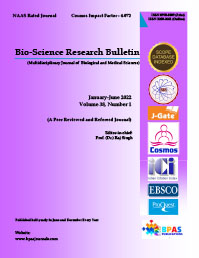Light and Scanning Electron Microscopy Studies on the Parasitic Mite Affecting Honey Bee Apis mellifera
DOI:
https://doi.org/10.48165/bpas.2023.39.1.5%20Keywords:
Parasitic mite, Apis mellifera, Acari, Tropilaelaps, Light microscopy, Scanning Electron MicroscopyAbstract
The most significant of the social insects, honey bees (Apis mellifera) are the primary pollinators of domesticated plants and contribute to the stability of ecosystems. The decline in the number of bee populations due to parasitic mites has a substantial and detrimental effect on the honey bee population. Mites (Acari) have grown to be a serious global issue for beekeepers all over the world. The current study was designed to investigate the ultra-structure and morphology of the parasitic mite (Tropilaelaps), an ectoparasite of the European honeybee, Apis mellifera. In order to conduct this study, the mites were collected from apiaries located in and around different regions of Lucknow, Uttar Pradesh. The morphological identification was done by Light Microscopy while the ultra-structural assessment was carried out with the help of a Scanning Electron Microscope (SEM). The results of this preliminary study revealed the presence of one of the main damaging genera of mites viz., Tropilaelaps. Light and Scanning electron microscopy revealed the dorsal shield, the ventral shields (metapodal shield, epigynal shield, and anal shield), and the genital plate on the ventral side. Peritreme, tritosternum, gnathosoma, chelicerae, and four pairs of legs were observed in detail as well as the presence of irregular setae all over the body. The study of morphological features of the Tropilaelaps mite will provide additional insights into the taxonomy of the parasite as well as contribute information towards further management of these parasites.
References
Akimov, I., Benedyk, S., Zaloznaya, L. (2004). Complex analysis of morphological characters of Gamasid mite Varroa destructor (Parasitiformes, Varroidae).
Allen, M., Ball, B., (1996). The incidence and world distribution of honey bee viruses. Bee World, 77, 141–162.
Anderson, D.L., Morgan, M.J. (2007). Genetic and morphological variation of bee parasitic Tropilaelaps mites (Acari: Laelapidae): new and re-defined species. Exp. Appl. Acarol. 43, 1–24.
Anderson, D.L., Roberts, J.M. (2013). Standard methods for Tropilaelaps mites research. J. Apic. Res. 52, 1–16.
Bautz, R.A., Coggins, J.R. (1992). Scanning electron microscopy of female Varroa jacobsoni (Arthropoda: Acarina), ectoparasite of the honeybee Apis mellifera. Trans. Am. Microsc. Soc. 28–35.
Boot, W., Schoenmaker, J., Calis, J., Beetsma, J. (1995). Invasion of Varroa jacobsoni into drone brood cells of the honey bee, Apis mellifera. Apidologie 26, 109–118.
Delfinado, M.D., Baker, E.W. (1961). Tropilaelaps, a new genus of mite from the Philippines (Laelaptidae [s. lat.]: Acarina). Fieldiana Zool. 44, 53.
Delfinado-Baker, M., Rath, W., Boecking, O. (1992). Phoretic bee mites and honeybee grooming behavior. Int. J. Acarol. 18, 315– 322.
Dietemann, V., Nazzi, F., Martin, S.J., Anderson, D.L., Locke, B., Delaplane, K.S., Wauquiez, Q., Tannahill, C., Frey, E., Ziegelmann, B., et al. (2013). Standard methods for Varroa research. J. Apic. Res. 52, 1–54.
Downey, D.L., Winston, M.L., (2001). Honey bee colony mortality and productivity with single and dual infestations of parasitic mite species. Apidologie, 32, 567–575.
Griffiths, D., Needham, G., Page Jr, R., Delfinado-Baker, M., Bowman, C. (1988). Functional morphology of the mouthparts of Varroa jacobsoni and Tropilaelaps clareae as
a basis for the interpretation of their life styles.
Koeniger, N., Muzaffar, N. (1988). Lifespan of the parasitic honeybee mite, Tropilaelaps clareae, on Apis cerana, dorsata and mellifera. J. Apic. Res. 27, 207–212.
Liu, T., (1982). A scanning electron microscope study on the female mite Varroa jacobsoni (Oudemans 1904).
Millonig, G. (1961). Advantages of a phosphate buffer for O_5O_4 solutions in fixation. J Appl Phys. 32, 1637.
Muli, E., Patch, H., Frazier, M., Frazier, J., Torto, B., Baumgarten, T., Kilonzo, J., Kimani, J.N., Mumoki, F., Masiga, D., et al. (2014). Evaluation of the distribution and impacts of parasites, pathogens, and pesticides on honey bee (Apis mellifera)
populations in East Africa. PLoS One 9, e94459.
Peng, Y.-S.C., Fang, Y., Xu, S., Ge, L., Nasr, M.E. (1987). Response of foster Asian honeybee (Apis cerana Fabr.) colonies to the brood of European honeybee (Apis mellifera L.) infested with parasitic mite, Varroa jacobsoni Oudemans. J. Invertebr. Pathol. 49, 259–264.
Rinderer, T.E., de Guzman, L.I., Delatte, G., Stelzer, J., Lancaster, V., Kuznetsov, V., Beaman, L., Watts, R., Harris, J. (2001). Resistance to the parasitic mite Varroa destructor in honey bees from far-eastern Russia. Apidologie, 32, 381–394.
Smiley, R. (1991). Mites (Acari). Insect Mite Pests Food Illus. Key U. S. Dep. Agric. Agric. Handb. 3–44.
